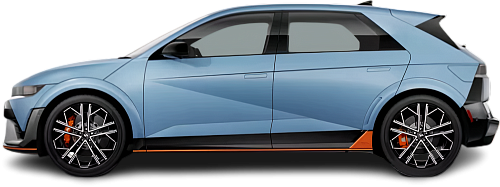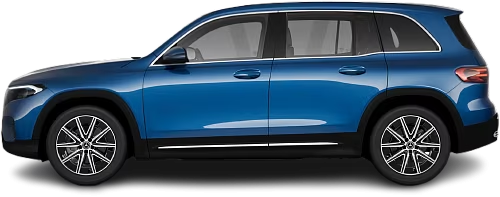Global EV Comparison: Hyundai Ioniq 5 N vs Mercedes EQB 300 4MATIC
Struggling to Decide? Let AI Help!
Your AI Summary Is Ready!
General Info
Both vehicles are currently in production and can be purchased new. The Hyundai Ioniq 5 N (2023-…) has a starting price of €75560, compared to the Mercedes EQB 300 4MATIC (2023-…), which starts at €55519.
The two vehicles share the same body style: SUV.
| Property | Hyundai Ioniq 5 N | Mercedes EQB 300 4MATIC |
|---|---|---|
| Years of Production | 2023-… | 2023-… |
| Current Status | Produced | Produced |
| Country of Manufacture | Indonesia, Singapore, South Korea | Hungary |
| Body Style | SUV | SUV |
| Market Availability | EU, USA | EU, USA |
| Price Europe (New) | €75560 | €55519 |
| Price Europe (Used) | €56499 | €34900 |
| GCC Score | 6.8 | 6 |
Range and Efficiency
While the Hyundai Ioniq 5 N (2023-…) offers a longer real-world range and a bigger battery, it is less energy-efficient than the Mercedes EQB 300 4MATIC (2023-…).
| Property | Hyundai Ioniq 5 N | Mercedes EQB 300 4MATIC |
|---|---|---|
| Range (EPA) | 356 km | 330 km |
| Range (WLTP) | 450 km | 448 km |
| Range (GCC) | 360 km | 350 km |
| Battery Capacity (Nominal) | 84 kWh | 69.7 kWh |
| Battery Capacity (Usable) | 80 kWh | 66.5 kWh |
| Efficiency per 100 km | 22.2 kWh/100 km | 19 kWh/100 km |
| Efficiency per kWh | 4.5 km/kWh | 5.26 km/kWh |
| Range and Efficiency Score | 4.9 | 5.8 |
Charging
The Hyundai Ioniq 5 N (2023-…) features an advanced 800-volt architecture, whereas the Mercedes EQB 300 4MATIC (2023-…) relies on a standard 400-volt system.
The Hyundai Ioniq 5 N (2023-…) offers faster charging speeds at DC stations, reaching up to 240 kW, while the Mercedes EQB 300 4MATIC (2023-…) maxes out at 100 kW.
Both vehicles are equipped with the same on-board charger, supporting a maximum AC charging power of 11 kW.
| Property | Hyundai Ioniq 5 N | Mercedes EQB 300 4MATIC |
|---|---|---|
| Max Charging Power (AC) | 11 kW | 11 kW |
| Max Charging Power (DC) | 240 kW | 100 kW |
| Architecture | 800 V | 400 V |
| Charge Port | CCS Type 2 | CCS Type 2 |
| Charging Score | 7.9 | 5.4 |
Performance
Both vehicles are all-wheel drive.
The Hyundai Ioniq 5 N (2023-…) boasts greater motor power and accelerates faster from 0 to 100 km/h.
| Property | Hyundai Ioniq 5 N | Mercedes EQB 300 4MATIC |
|---|---|---|
| Drive Type | AWD | AWD |
| Motor Type | PMSM (front), PMSM (rear) | IM (front), PMSM (rear) |
| Motor Power (kW) | 478 kW | 168 kW |
| Motor Power (hp) | 641 hp | 225 hp |
| Motor Torque | 740 Nm | 390 Nm |
| 0-100 km/h | 3.4 s | 8 s |
| Top Speed | 260 km/h | 160 km/h |
| Performance Score | 7.2 | 3.7 |
Dimensions
The Hyundai Ioniq 5 N (2023-…) has a wider body, offering a more shoulder room, while the Mercedes EQB 300 4MATIC (2023-…) stands taller for a more elevated driving position. Despite these differences, their lengths are nearly identical.
The Hyundai Ioniq 5 N (2023-…) boasts a more extended wheelbase.
| Property | Hyundai Ioniq 5 N | Mercedes EQB 300 4MATIC |
|---|---|---|
| Length | 4715 mm | 4684 mm |
| Width (with Mirrors) | 2152 mm | 2020 mm |
| Width (w/o Mirrors) | 1940 mm | 1834 mm |
| Height | 1585 mm | 1667 mm |
| Wheelbase | 3000 mm | 2829 mm |
Cargo and Towing
The Mercedes EQB 300 4MATIC (2023-…) provides more cargo capacity, featuring both a larger trunk and more space with the rear seats folded.
Neither car is equipped with a frunk (front trunk).
The Mercedes EQB 300 4MATIC (2023-…) has a towing capacity of up to 1700 kg, whereas the Hyundai Ioniq 5 N (2023-…) is not officially rated for towing in the EU.
| Property | Hyundai Ioniq 5 N | Mercedes EQB 300 4MATIC |
|---|---|---|
| Number of Seats | 5 | 5, 7 |
| Curb Weight | 2275 kg | 2165 kg |
| Cargo Volume (Trunk) | 480 l | 495 l |
| Cargo Volume (Max) | 1540 l | 1710 l |
| Cargo Volume (Frunk) | - Cargo Volume (Frunk) | - Cargo Volume (Frunk) |
| Towing Capacity | - Towing Capacity | 1700 kg |
| Cargo and Towing Score | 6.3 | 7.4 |




